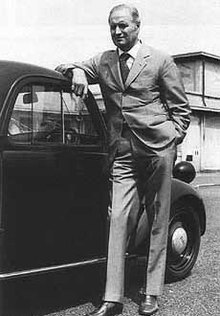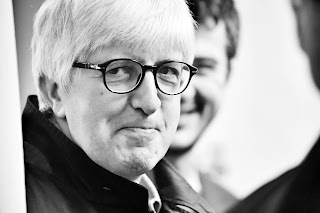 |
| Dante Giacosa worked for Fiat automobiles for almost half a century |
Designer known as ‘the father of the Cinquecento'
The automobile engineer Dante Giacosa, who worked for the Italian car maker Fiat for almost half a century and designed the iconic Fiat 500 - the Cinquecento - in all its incarnations as well as numerous other classic models, died on this day in 1996 at the age of 91.
Giacosa was the lead design engineer for Fiat from 1946 to 1970. As such, he was head of all Fiat car projects during that time and the direction of the company’s output was effectively entirely down to him.
In addition to his success with the Cinquecento, Giacosa’s Fiat 128, launched in 1969, became the template adopted by virtually every other manufacturer in the world for front-wheel drive cars.
His Fiat 124, meanwhile, was exported to the Soviet Union and repackaged as the Zhiguli, known in the West as the Lada, which introduced Soviet society of the 1970s to the then-bourgeois concept of private car ownership.
Born in Rome, where his father was undertaking military service, Giacosa's family roots were in Neive in southern Piedmont. He studied engineering at the Polytechnic University of Turin.
 |
| Dante Giacosa, standing between the familiar shape of the Nuovo Cinquecento and the original 'Topolino' |
In 1929, Senator Giovanni Agnelli, co-founder of the Fiat company (and grandfather of Gianni), asked his engineers to design an economy car that would sell for 5,000 lire.
There was an emphasis on producing economical small cars in all the industrialised European countries. Giacosa's new 500cc vehicle, originally called the Zero A, appeared for the first time in 1934 and was immediately hailed as a triumph of engineering subtlety.
The vehicle was only just over three metres (10 feet) in length, yet Giacosa had managed to squeeze in a four-cylinder engine and space for two adults and two children. The radiator was squeezed in behind the engine for compactness, which allowed a sharply sloping nose.
 |
| Giacosa's Fiat 600 was a bigger version of the Fiat 500 but with space for four adults and some luggage |
During the Second World War, Giacosa returned to working on aero engines but also began planning a post-war range of economy cars.
However, in the financial chaos that followed, the Topolino was priced at 720,000 lire when Fiat resumed its production in 1945, a long way from Agnelli’s dream. The best that ordinary Italians could aspire to at the time was a bicycle or, later, perhaps a Vespa or Lambretta scooter.
But the needs of Italians changed with the baby boom of the early 1950s, by which time they had more disposable income. What they wanted was a family car, bigger and more comfortable than the Topolino, and Giacosa met that need by designing the Fiat 600.
 |
| Giacosa's Cisitalia D46 racing car, which he designed for the entrepreneur and racing driver Piero Dusio |
However, as the narrow streets of Italian cities became busier, smaller cars such as the old Topolino that could whisk through traffic and park in a small spot, came back into vogue. Giacosa met that need by designing a new Cinquecento - the familiar Nuovo 500 - based on the rear-engined pattern of the 600, with seats for four adults, an open roof and a top speed of 100kph (60mph). It was an immediate hit, selling 3.7 million models before production stopped in 1973.
In addition to his mass production cars for Fiat, Giacosa also worked on behalf of the entrepreneur Piero Dusio and his Consorzio Industriale Sportivo Italia company to design a single-seater racing car cheap known as the Cisitalia D46. The car scored multiple successes in competition, particularly in the hands of drivers as talented as the brilliant Tazio Nuvolari, winner of 24 Grands Prix in the pre-Formula One era.
 |
| Fiat's extraordinary motor production plant at Lingotto, a few kilometres from the centre of Turin |
The former Fiat plant in the Lingotto district of Turin was once the largest car factory in the world, built to a linear design by the Futurist architect Giacomo Matte Trucco and featuring a rooftop test track made famous in the Michael Caine movie, The Italian Job. Redesigned by the award-winning contemporary architect Renzo Piano, it now houses concert halls, a theatre, a convention centre, shopping arcades and a hotel, as well as the Automotive Engineering faculty of the Polytechnic University of Turin. The former Mirafiori plant, situated about 3km (2 miles) from the Lingotto facility, is now the Mirafiori Motor Village, where new models from the Fiat, Alfa Romeo, Lancia and Jeep ranges can be test driven on the plant's former test track.
| The village of Neive in Piedmont is at the heart of an important wine production area |
Neive, from which Giacosa’s family originated, is a large village in the Cuneo province of Piedmont region, about 12km (7 miles) north of the larger town of Alba and 70km (44 miles) southeast of Turin. It is best known as the centre of a wine producing region but more recently has enjoyed a boom in agritourism among visitors wishing to experience a rural Italian village. The centre of the village is the charming narrow Piazza Italia and the most important landmark the 13th century Torre Comunale dell’Orologio, the tallest building in the village. The village is beautifully presented and listed as one of the Borghi Più Belli d’Italia - the most beautiful small towns of Italy. The Baroque Chiesa Di San Pietro is one of the most important churches, with several beautiful art works by artists of the region. The notable wines produced in the area include Barbaresco, Barbera, Dolcetto d’Alba and the sweet dessert white wine Moscato d’Asti.
More reading:
How Fiat boss Gianni Agnelli became more powerful than politicians
Giovanni Agnelli and the 'horseless carriage' that launched Italy's biggest automobile company
How little 'Pinin' Farina became the biggest name in Italian car design
Also on this day:
1425: The birth of Bianca Maria Visconti - Duchess of Milan
1675: The birth of intellectual leader Pope Benedict XIV
1941: The birth of comic book artist Franco Bonvicini
Home









